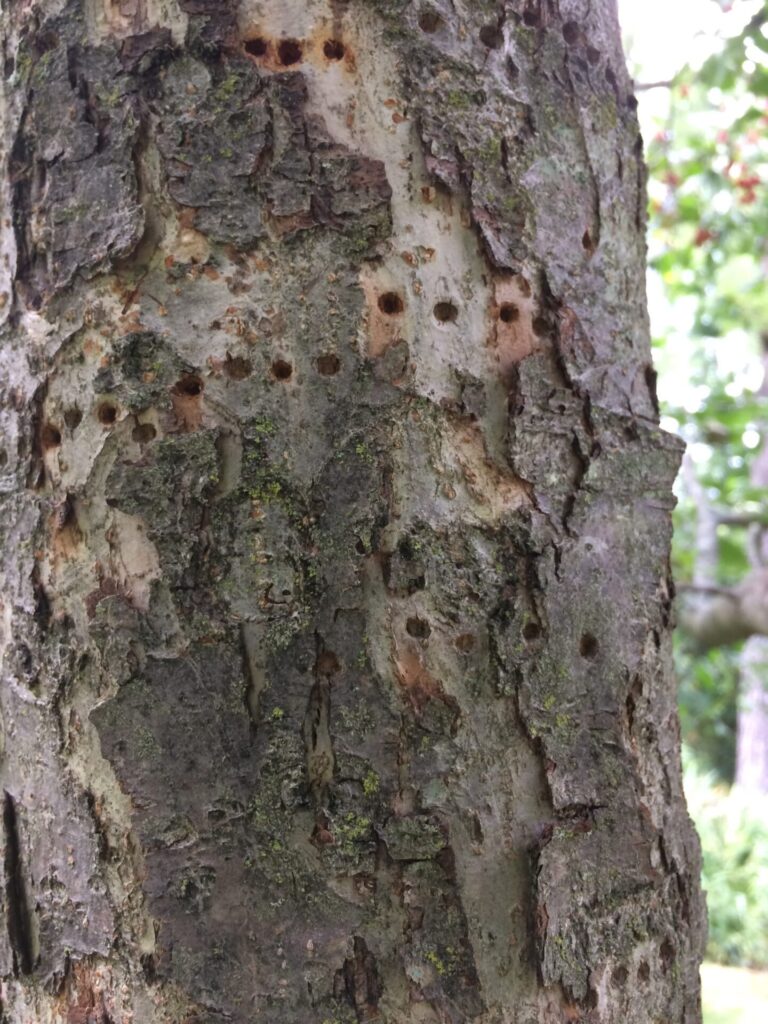
I have a crab apple tree that gave a bumper crop of apples this year so I was very concerned to see rows of holes in the trunk – what are causing these and should I be concerned? Thank you!
Jo Mather
Thank you for contacting Toronto Master Gardeners about this problem. I can certainly understand your dismay in seeing this damage to an otherwise productive tree.
The holes on your crabapple occur in rows and there doesn’t appear to be any ‘frass’ – the saw dust material left by borer insects around the openings on the trunk. Have you noticed piles of fine sawdust at the base of your tree? With the absence of frass, this looks like the work of a medium sized bird in the woodpecker family- the Yellow Bellied Sap Sucker. I have attached a link below, so that you can recognize this native bird, if they are the culprit.
In the spring, when the weather warms up enough for the sap to flow, they make small, round, shallow holes- usually in horizontal rows, on the trunks of trees including, but not typically, Crabapple species. These holes create sap wells where they return to drink the sap and eat the occasional insect. Their holes range in size from 1/4- 3/8 of an inch.
To protect the tree from these birds you can wrap a barrier- such as a net, burlap or 1/4 hardware mesh, around the tree trunk. The woodpeckers are active in spring and fall, so you can remove the trunk protection over the summer and winter months.
Another remedy is to use fright tactics like hanging shiny, reflective objects that move in the wind—aluminum pie plates, reflective tape or old CDs or DVDs—anything that flashes light. Like plastic owls that are effective until birds become accustomed to them, these objects have to be relocated from time to time.
If you do find piles of frass at the base of your tree or around the holes on the trunk, your tree is likely the host of a borer insect. Your pest could be one of several insect pests that enjoy a crabapple host including the shot hole borer, apple tree borer and dogwood borer. These insects attack healthy trees and deposit their larvae by boring into the branches and trunk. Apple tree borer holes are found near the base of the tree, and are exit holes which appear in spring as the mature beetles emerge. Unfortunately, the prognosis for the tree is poor.
Here are some remedies for these pests:
•. Control measures (sanitize the area by removing infected or infested plant material (do not compost). This will disrupt the life cycle of the insect and prevent it from reproducing; encourage beneficial organisms such as spiders and birds that consume insects);
•. Remove pests (eg. blast with water spray; pick off by hand; vacuum off insects);
•. Control pests with physical barriers (eg. using sticky stem wraps, cards, or boards).
Moving up the scale for intervention, you can also try organic insecticides such as pheromone traps and insecticidal soap. Finally, you can try beneficial nematodes, microscopic round worms. Nematodes can be injected directly into the entry hole made by tunneling pests. They kill destructive boring insects but cannot persist inside the plants. A nematode treatment can be repeated. There are no known side effects for any animals or plants. Take care to follow the directions on the package.
For more information, please take a look at these links:
https://extension.umd.edu/hgic/topics/woodpeckers-and-sapsuckers
For information on identification and management of fruit tree borers:
https://extension2.missouri.edu/g7190

